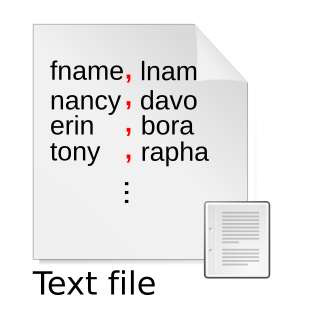
A regular expression, regex or regexp is a sequence of characters that define a search pattern. Usually such patterns are used by string searching algorithms for "find" or "find and replace" operations on strings, or for input validation. It is a technique developed in theoretical computer science and formal language theory.
Ruby is an interpreted, high-level, general-purpose programming language. It was designed and developed in the mid-1990s by Yukihiro "Matz" Matsumoto in Japan.
A bracket is either of two tall fore- or back-facing punctuation marks commonly used to isolate a segment of text or data from its surroundings. Typically deployed in symmetric pairs, an individual bracket may be identified as a left or right bracket or, alternatively, an opening paired bracket or closing paired bracket, respectively, depending on the directionality of the context.
In computer science, lexical analysis, lexing or tokenization is the process of converting a sequence of characters into a sequence of tokens. A program that performs lexical analysis may be termed a lexer, tokenizer, or scanner, though scanner is also a term for the first stage of a lexer. A lexer is generally combined with a parser, which together analyze the syntax of programming languages, web pages, and so forth.
Programming style, also known as code style, is a set of rules or guidelines used when writing the source code for a computer program. It is often claimed that following a particular programming style will help programmers read and understand source code conforming to the style, and help to avoid introducing errors.
A string literal or anonymous string is a type of literal in programming for the representation of a string value within the source code of a computer program. Most often in modern languages this is a quoted sequence of characters, as in x = "foo", where "foo" is a string literal with value foo – the quotes are not part of the value, and one must use a method such as escape sequences to avoid the problem of delimiter collision and allow the delimiters themselves to be embedded in a string. However, there are numerous alternate notations for specifying string literals, particularly more complicated cases, and the exact notation depends on the individual programming language in question. Nevertheless, there are some general guidelines that most modern programming languages follow.
In computer programming, an indentation style is a convention governing the indentation of blocks of code to convey program structure. This article largely addresses the free-form languages, such as C and its descendants, but can be applied to most other programming languages, where whitespace is otherwise insignificant. Indentation style is only one aspect of programming style.
In computer programming, a free-form language is a programming language in which the positioning of characters on the page in program text is insignificant. Program text does not need to be placed in specific columns as on old punched card systems, and frequently ends of lines are insignificant. Whitespace characters are used only to delimit tokens, and have no other significance.

A delimiter is a sequence of one or more characters for specifying the boundary between separate, independent regions in plain text or other data streams. An example of a delimiter is the comma character, which acts as a field delimiter in a sequence of comma-separated values. Another example of a delimiter is the time gap used to separate letters and words in the transmission of Morse code.
A computer programming language is said to adhere to the off-side rule if blocks in that language are expressed by their indentation. The term was coined by Peter J. Landin, after the offside rule in football. This is contrasted with free-form languages, notably curly-bracket programming languages, where indentation is not meaningful and indent style is only a matter of convention and code formatting.

IntelliJ IDEA is a Java integrated development environment (IDE) for developing computer software. It is developed by JetBrains, and is available as an Apache 2 Licensed community edition, and in a proprietary commercial edition. Both can be used for commercial development.

Notepad2 is a free and open-source text editor for Microsoft Windows, released under a BSD software license. It was written by Florian Balmer using the Scintilla editor component, and it was first publicly released in April 2004. Balmer based Notepad2 on the principles of Notepad: small, fast, and usable.
This comparison of programming languages compares the features of language syntax (format) for over 50 computer programming languages.
Coding conventions are a set of guidelines for a specific programming language that recommend programming style, practices, and methods for each aspect of a program written in that language. These conventions usually cover file organization, indentation, comments, declarations, statements, white space, naming conventions, programming practices, programming principles, programming rules of thumb, architectural best practices, etc. These are guidelines for software structural quality. Software programmers are highly recommended to follow these guidelines to help improve the readability of their source code and make software maintenance easier. Coding conventions are only applicable to the human maintainers and peer reviewers of a software project. Conventions may be formalized in a documented set of rules that an entire team or company follows, or may be as informal as the habitual coding practices of an individual. Coding conventions are not enforced by compilers.

In computer programming, a comment is a programmer-readable explanation or annotation in the source code of a computer program. They are added with the purpose of making the source code easier for humans to understand, and are generally ignored by compilers and interpreters. The syntax of comments in various programming languages varies considerably.
CoffeeScript is a programming language that compiles to JavaScript. It adds syntactic sugar inspired by Ruby, Python and Haskell in an effort to enhance JavaScript's brevity and readability. Specific additional features include list comprehension and destructuring assignment.

JetBrains s.r.o. is a software development company whose tools are targeted towards software developers and project managers.










